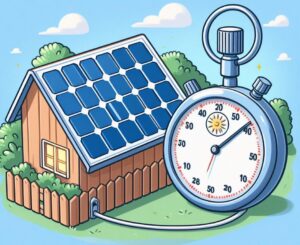introduction
In a time of environmental sustainability and the move to renewable energy, solar power is essential in a sustainable lighting system. Users’ most frequent query is, “How long do solar lights take to charge?” Solar lights for outdoor use, praised for their ease of installation and their independence from permanent power sources, are widespread in gardens and paths and also as security for houses across the globe.
The benefits are apparent; however, the efficiency of the charging process is an essential aspect of its reliability and efficiency.
“Join me as I investigate the charging time for solar lights and offer strategies to boost their efficiency. By implementing these tips, you can ensure your outdoor spaces stay brightly lit around the clock.”
Understanding Solar Light Charging

What is the Science Behind Solar Charging
Solar lighting might appear simple, but it represents a significant stride in utilizing renewable energy. The critical component of this technology comprises photovoltaic cells, commonly known as solar panels. These panels are composed of layers of specialized materials, typically silicon, designed to absorb sunlight.
When sunlight hits the photovoltaic panels, it stimulates electrons inside this semiconductor, which causes them to move quickly. The electrons’ movement creates an electric charge, which is later stored and directed into rechargeable batteries integrated into the solar illumination system.
This stored energy is used to power the light when required, usually at sunset. It’s the environment with a sustainable and green lighting system that uses renewable and abundant sunlight resources.
Factors that affect charging time
The time required for the solar lights to charge fully isn’t fixed in stone and may differ significantly. The most important factors that affect this are:
- Solar Intensity: The more direct and bright the sunlight is, the faster the solar lights will charge. Dark, overcast days or obstructions can drastically slow the charging process.
- Battery Capacity:
- A bigger battery takes more time to charge but can make the light last longer, possibly for several nights.
- Charging Efficiency: Charge controller efficiency, which regulates the voltage and current flowing from solar panels to batteries, could also affect charging speed. High-efficiency controllers typically will result in quicker charging.
Average Solar Light Charging Times
It is essential to control your expectations about the charging time of solar lights. Here’s a list of typical charges for different kinds of solar light:
- Lighting Pathways: Most of them are smaller and use lower-capacity batteries. These lights will take 6 to 12 hours to charge fully under optimal conditions.
- Outdoor Lights These lights, with larger batteries and panels, generally require 8-12 hours of sunlight to fully charge.
- Security lights: The most robust design. They may take as long as 15 hours to charge because of the larger panel and battery.
- Lights for Decoration: Often featuring distinctive designs, they could require different charging times based on the light’s size and the battery’s capacity.
- Spotlights are designed to shine in certain areas and require approximately 8-10 hours of sunshine at a full charge.
- Motion Sensor Lighting: These lights are equipped with sensors and require around 6-8 hours of sun to warrant they work energetically all night.
Also, think about the angle at which the solar panels are set to warrant that they receive maximum direct sunlight, which could dramatically increase the charging. For more in-depth discussions, suggestions, and stories of shared experiences with the maintenance of solar lighting, visit this forum on solar lighting. Members of the community share tips and insights on how to get the most value from solar-powered lights all year.
Variations in the seasons
In the summer, longer daylight hours and more direct light increase solar charge efficiency and result in significantly quicker charging times. However, this is not the case during winter, when shorter daylight hours and less sun intensity lengthen the charging time duration, affecting the overall accumulation of energy.
This seasonal variation highlights the importance of maximizing solar panel placement and considering energy storage options to ensure the power supply is constant throughout the year.
Tips for faster charging

To maximize the charging process for your solar light bulbs, There are a few actions you can follow:
- Positioning: Ensure the maximum amount of direct sunshine reaches your solar panels. Make sure they have no obstacles in their way, like building branches or trees.
- Cleaning: vacuum the solar panels to remove dust and other materials that could reduce their performance.
- The Management of Batteries: When possible, remove the battery from the charger and recharge it with an appropriate charger during the off-season to keep it running at its peak.
- Inspect: Conduct annual inspections to detect and repair wear and tear to ensure they operate at their peak.
- Monitor System: Use monitoring software to monitor the efficiency of your solar panel, which allows for quick adjustments and maximizing energy production.
Technological Innovations
Solar technology light is rapidly evolving. Specific new models include better solar panels and charge controllers that speed up the charging process considerably.
Real-World Examples
Consumers in different geographical regions and latitudes can often observe variations in their phones’ charging time. Those who live in warmer climates like Scandinavia frequently report longer charging times. The lower efficiency of batteries at cold temperatures explains this phenomenon.
In contrast, people living in warmer climates, such as the Mediterranean, have noticed faster charging times, which could be because of better operational conditions of battery technology at warmer temperatures.
This difference in charging speed and battery endurance highlights the technological advances achieved by top brands and how important it is to invest in high-quality products to ensure consistent performance throughout time.
Conclusion
Understanding the charging time of solar lights is essential for both the longevity and proper operation of these environmentally friendly devices. Always place your lights to maximize sunlight exposure, perform regular maintenance, and consider investing in the latest technological advancements to increase your solar experience. When making educated decisions regarding solar energy, you can increase the value and durability of these environmentally friendly lighting options.
The future is bright, and advancements in solar technology are expected to lower charge times even more, increasing the appeal and usefulness of solar lights. If you’re experimenting with solar-powered lighting on your first attempt or already an expert with knowledge to share, your feedback will be valuable. Join the discussion and benefit to illuminate the path towards an environmentally sustainable, greener future. For more information about advances in solar lighting, visit Solar Innovations.





